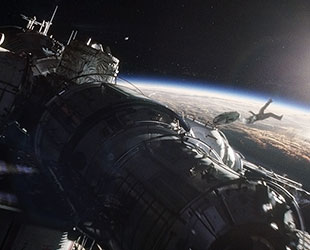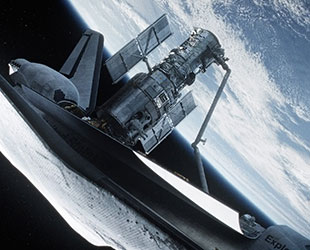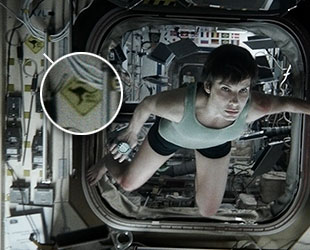October 4, 2013 – Now that "Gravity" is pulling audiences into theaters, moviegoers are getting their first look at the dramatic thriller about stranded spacewalkers.
The Warner Bros. Pictures' feature, which opened Friday (Oct. 4) nationwide, is a visual spectacle, in no small part due to director Alfonso Cuarón's desire to pay tribute to space exploration, a subject that has fascinated him since childhood.
"For me that whole idea of doing the setting in space and honor what is in there, not trying to invent, that was the thing," he told collectSPACE. "Why invent when you have the most amazing technology up there?"
"Gravity" showcases the space shuttle, the Hubble Space Telescope, the International Space Station, and Russia's Soyuz spacecraft in stunning precision, including details that only those who share Cuarón's passion for spaceflight may recognize as being true to life. The film is "a piece of fiction," as the director puts it, and does take liberties with how the spacecraft operate in orbit, but Cuarón did not set out to make a documentary.

A scene outside the International Space Station from the Warner Bros. Pictures' dramatic thriller, "Gravity." (Warner Bros. Pictures) |
He did however, include some obvious and not so obvious nods to real space history — and even past space films. These may not be "easter eggs" in the traditional sense of hidden in-jokes or references, some of them may not have even been intentional, but here are five details that space enthusiasts might only notice in "Gravity."
Warning: Spoilers follow.
No. 5: Mission Control cameo
Not long into the movie, veteran space shuttle commander Matt Kowalski (George Clooney) calls down to Earth with the ominous warning, "Houston, I have a bad feeling about this mission."
Given what is about to happen in "Gravity," it could be the film's take on Tom Hanks' famous "Apollo 13" movie line, "Houston, we have a problem." (In reality, the real James Lovell radioed "Houston, we've had a problem," a nitpick, but one that space enthusiasts are quick to point out.) In "Gravity" however, the "bad feeling" is only a segue into a funny story.
But who is that answering Kowalski's call from Mission Control? Though never seen on screen, the voice belongs to none other than Ed Harris, who portrayed flight director Gene Kranz in the 1995 Ron Howard film (and while we're playing "Five Degrees of [Spaceflight] Separation," Harris also appeared in "The Right Stuff" as John Glenn).
You hear that Dr. Ryan Stone? Failure is not an option!
No. 4: Around the world in one screening
Soon after communications are cut with Mission Control, Kowalski has Dr. Stone (Sandra Bullock) set a timer for 90 minutes, having figured out how much time it will take for the satellite debris that destroyed their shuttle to round the Earth and wreck havoc again.
That hour and a half is not arbitrary. The real International Space Station takes about 90 minutes to orbit the planet, traveling at 17,500 miles per hour (not the "50,000 miles per hour" Kowalski uses to make his calculations).
"Gravity" has a running time of — you guessed it — 90 minutes. Thus, in the time that audiences experience the movie, the space station flying 240 miles (390 kilometers) above has completed one trip around the Earth. (It's not uncommon for the astronauts and cosmonauts aboard the orbiting outpost to watch movies on DVD; if Warner Bros. Pictures arranges to send "Gravity" to the station, it could make for a novel way to spend an orbit.)
Based on the number of times Dr. Stone encounters the satellite debris cloud, it seems she completes three trips around the planet after being separated from the shuttle.
No. 3: Scoring the space shuttle
For reasons unknown, Alfonso Cuarón decided to give his shuttle a fictional name: Explorer. The orbiters in NASA's fleet were Columbia, Challenger, Discovery, Atlantis, and Endeavour.
There is a full-scale shuttle mockup in Houston that had "Explorer" as its name, but it is being re-christened due to an unrelated series of events on Saturday (Oct. 5).

A scene from Warner Bros Pictures' "Gravity" showing the space shuttle Explorer and the Hubble telescope. (Warner Bros. Pictures) |
But it may have also been that Explorer wasn't always the intended name for the film's orbiter. The hint to this comes from the movie's soundtrack.
Each of the tracks from composer Steven Price's spatial score are titled to correspond with the scene in "Gravity," which in several cases translates to just the name of the spacecraft. For example, track seven is "I.S.S." and track 13 is "Soyuz."
Track four, which is the music that accompanies Kowalski and Stone as they return to their badly damaged shuttle is not titled "Explorer" but rather "Atlantis."
Atlantis was NASA's final space shuttle to fly in space.
No. 2: Kowalski's cosmonaut competitor
Several times, Matt Kowalski references the record set by a certain cosmonaut for total time spacewalking, a record the character eventually breaks, though not by the best of circumstances.
That cosmonaut, Anatoly Solovyev, does indeed hold the record and is the only real-life space explorer to have his name dropped in "Gravity."
Solovyev, who at 65 is now retired, ventured outside into the vacuum of space on the first of his 16 extravehicular activities (EVAs) in 1990. Over the course of four of his five flights into orbit, the cosmonaut logged an amazing 82 hours and 22 minutes — almost three and a half days — on spacewalks.
Kowalski says upon passing the record that it's not one he thinks others will be breaking any time soon. Outside the fictional world of the movies, the same could very well be said for Solovyev's achievement.
No. 1: Kangaroo crossing
As mentioned, great attention was paid to reproducing the spacecraft in "Gravity" because Cuarón wanted to honor the men and women behind the space program.
That may have resulted in a tribute for the film's astronaut advisor.
As earlier reported, NASA astronaut Cady Coleman spoke to Sandra Bullock from the space station, but that was done unofficially, arranged through their family members. As the "Gravity" credits reveal, astronaut Andrew Thomas provided the movie's technical advice.
Thomas, who joined NASA in 1992, flew four spaceflights, including three shuttle missions and a long-duration stay onboard the Russian space station Mir. "Gravity" appears to pay homage to Thomas with two "blink-and-you-might-miss-them" references.
Onboard the shuttle Explorer, the crew's STS-157 mission patch lists one of the astronauts as "Thomas."

A scene from Warner Bros Pictures' "Gravity" showing Dr. Ryan Stone floating by a kangaroo crossing sign. (Warner Bros Pictures) |
And inside the International Space Station, as Ryan Stone floats through the modules, she flies through a node with a small yellow crossing sign stuck to one of the walls. The sign has the silhouette of a kangaroo.
Although Andrew Thomas is a U.S. citizen and flew as a NASA astronaut, he was born in Australia.
